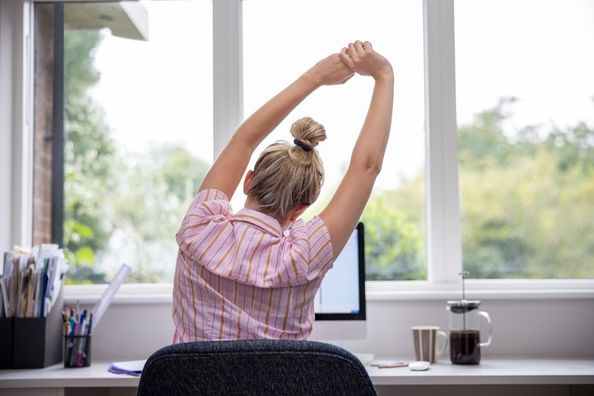Whether you have always worked remotely or recently transitioned to working from home during the pandemic, setting up an at-home workspace is not always an easy task. Longer periods of sitting, makeshift desks and uncomfortable chairs while working from home can all cause muscle pain due to poor posture. Luckily, there are many ways you can transform your home office to improve your health.
Office chair
Whether you have a traditional desk chair or are using another chair from around the house, it is important to choose a chair that is upright and supports your back. Your home office should include a chair that is a proper height from the ground based on your height. To achieve this, adjust your chair so that your feet are resting comfortably on the floor in order to prevent lower back pain. Using books or other flat objects to rest your feet on can also help align your pelvis2.
If your office chair has adjustable arm rests, ensure they are positioned to allow for relaxed shoulders and a neutral arm position. Avoid leaning against your arm rest as this can put pressure on the nerves in your elbow.
Another way to transform your chair and reduce lower back pain includes utilizing a lumbar pillow. Supplementary materials such as a firm pillow or a tightly rolled up towel are other great options for lumbar support. Proper placement of lumbar back support includes finding the natural curve of your spine in your lower black.
Desk workspace
The abrupt change to working from home during COVID-19 left a lot of people without a desk that is suitable for long hours of work. If you do not adjust your work surface properly, you may experience muscle strain due to poor posture such as straining your neck to look at your computer. To avoid this, raise your monitor to be at eye level after adjusting your chair to the proper height. Additionally, make sure to place your monitor, keyboard and mouse directly in front of you. Prolonged turning of the head to look at a monitor can lead to neck and shoulder aches.
Another way to help minimize muscle pain includes adjusting your desk so that when you type, your elbows are at a 90-degree angle. There should also be space between the top of your legs and the bottom of the desk. This ensures you can adjust how you are sitting throughout the workday.
Additionally, being out of the office can often lead to a more sedentary workday. Standing desks are a great way to reduce shoulder, back and neck pain caused by sitting all day. It is recommended that you ease into using the standing desk by only standing for 15 minutes at a time. Those who do utilize a standing desk should consider getting an anti-fatigue mat to stand on. Another option is to buy a small stool and rotate one foot on and one foot off to help avoid overuse of the muscles you use while you stand3. Another important factor to consider is the shoes you wear while using a standing desk. Flat shoes are the best option to wear instead of shoes with heels or not wearing shoes at all.
Workspace add-ons
Ergonomic keyboards allow you to work for longer periods of time on your computer while protecting you from hand, wrist and shoulder discomfort. Ergonomic keyboards have cushioned pads that can help prevent you from bending your wrists upwards while typing. If your current keyboard is propped up in the back, simply retracting the height adjustment at the back of the keyboard or putting it on a tray with a slight downward tilt can help improve your hand position. The length of the keyboard can also be adjusted to your shoulder width to help avoid shoulder pain. Ergonomic or split keyboards promote a neutral wrist position which can minimize the strain on the muscles that cross our wrist. Additionally, many keyboards are designed with “light touch keys” that require less force throughout the fingers when typing.
Another office item to benefit your health includes an external mouse which can help minimize shoulder pain. Those who use their laptop’s mouse pad often turn their shoulders inward which can cause shoulder and neck pain. Choosing a mouse that is more conformed to the size and shape of your hand can help reduce strain of the fingers and thumb. A vertical mouse is a great option since it promotes a neutral wrist position. To avoid repetitive wrist motion when using the mouse, attempt to use your hand, wrist and forearm as a unit to move the mouse. Also, resting your hand off of the mouse when not in use can reduce strain in the forearm and wrist.
Additionally, utilizing a timer can help remind you to stand up, walk around while reading a document or even stretch while remaining seated. A good seated stretch includes reaching your arms up, looking up and down, or arching your back for 10 to 15 seconds. Setting your timer to go off every 30 to 45 minutes will help you remember to reposition your body to avoid muscle pain throughout the workday.
If you’re feeling aches and pains related to your home office set up, schedule an appointment with one of our Physical and Occupational Therapists today by calling 630−967−2000 or click here for more information.
1Gabriel, PT, OCS, CSCS, C. (2019, February 21). 7 of Your Most Burning Questions about Standing Desks Answered by a Physical Therapist. In Ortho Carolina. Retrieved from https://www.orthocarolina.com/…
2Bergquist, A., & Urban, K. (2020, April 24). Home Workspace Causing Back and Neck Pain? Try This. In Michigan Health. Retrieved from https://healthblog.uofmhealth.org/wellness-prevention/home-workspace-causing-back-and-neck-pain-try
3Shmerling, MD, R. H. (2016, September 23). The truth behind standing desks. In Harvard Health Publishing. Retrieved from https://www.health.harvard.edu…
Health Topics:








